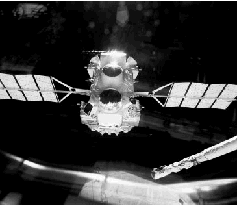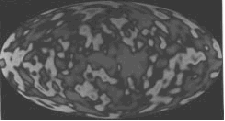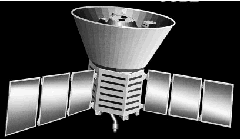
Deployment of the Compton Gamma Ray Observatory from the Space Shuttle Atlantis in 1991
energy gamma rays from several previously unknown sources. Satellites like CGRO can observe continuously for years instead of the few hours balloon experiments provide.
In May, 1992 a Delta II rocket boosted the Extreme Ultraviolet Explorer (EUVE) into orbit. This satellite continues to study the far ultraviolet part of the spectrum. One unexpected result from this mission was the distances at which ultraviolet sources were seen. The scientists expected to see ultraviolet radiation only from within 50 light years of the Sun. EUVE detected extreme ultraviolet emissions from distant galaxies in its first year of operation.

Thermal background radiation measured
by the COBE spacecraft
Using space-borne instruments, scientists now map the universe in many wavelengths. Satellites and telescopes provide data in radio wave, microwave, infrared, visible, ultraviolet, x-ray, and gamma ray. By comparing data from an object in the sky, in all wavelengths, astrono-mers are learning more about the history of our universe.

Artist's concept of the COBE spacecraft in
space
Note: For more information about each of these missions and the discoveries that are being made, refer to the reference section of this guide or contact NASA Spacelink, the electronic information service described on page 89.

Gamma ray bursts detected by the Compton Gamma
Ray Observatory